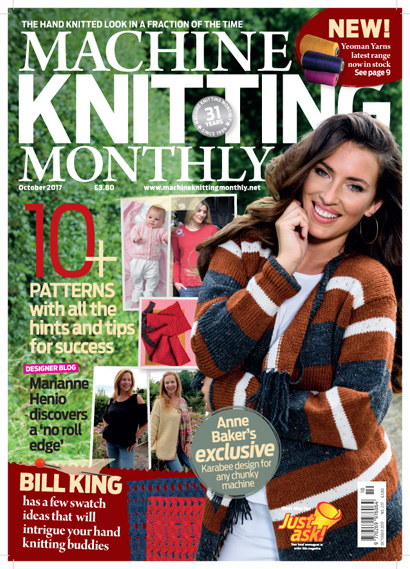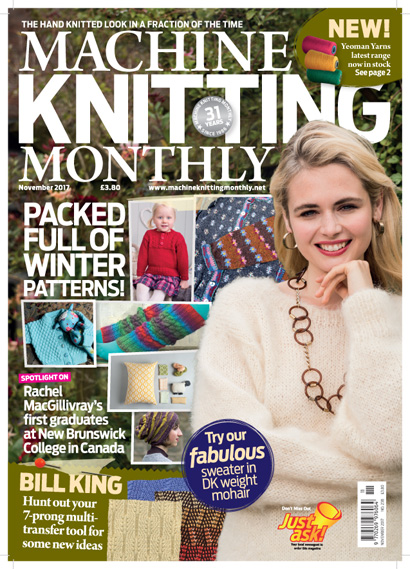Free download
I’m really enjoying Marianne Henio’s articles. I think she’s really generous allowing knitters to download her booklet ‘How to Design, Write and Convert your own knitting patterns’. My daughter, who lives in Canada, has just bought her first knitting machine so I’ve emailed Marianne’s offer to her. I agree with the reader who said that she’d not like to see MKM go digital, so keep that body of yours going! Kind regards, Julia
Grab Marianne’s free guide on ‘How to Design, Write & Convert your own Knitting Patterns’. It’s online at http://modernknittingpatterns.com/your-free-guide/
Find Marianne’s designs at http://modernknittingpatterns.com/
Follow Marianne on Twitter at https://twitter.com/mariannehenio
Follow Marianne on Pinterest at https://uk.pinterest.com/mariannehenio/boards/
Follow Marianne on Facebook at https://www.facebook.com/groups/900734820016110/
Figure it out
I’ve been with you from the start and we MKM readers are such a happy bunch and you are our excellent team leader. I thought we all might enjoy something apparently doing the rounds on the Internet right now, to keep our brains going. I don’t have a computer, but my grandson is a tease and got me thinking about it. It’s just a bit of fun and an excuse to sit with the magazine a bit longer instead of getting on with the housework. Roughly speaking, try to work out what these seven words all have in common. They are Banana, Dresser, Grammar, Potato, Revive, Uneven and Assess. I spent forever thinking about it and threatened to stop his pocket money if he didn’t tell me the answer! Like me, you’ll kick yourself when you know what it is. Best wishes, Marjorie
(In all the words listed, if you take the first letter and place it at the end, it spells the same word backwards. Joan Lafferty often reminds us that machine knitters are daft and this proves it!)
All tucked up
I’m writing in the hope that you can help me. I’ve some patterns for tuck lace, but I don’t have any books or manuals that explain how to do it on my Brother 836. My manual doesn’t seem to tell me so I hope you can help. Yours sincerely, Alison
Thanks for your letter Alison and Pattern 221 is a good example. It’s taken from Brother Punchcard Pattern Vol. 4. On Brother single bed machines you’ve a card that’s punched out with both a tuck and a lace pattern. After transferring stitches for the lace pattern with the lace carriage, you need to do one of two things.
- If the needles are selected, push the tuck button(s) and move the K carriage.
- If the needles are not selected, push the ‘plain’ lever and move the K carriage.
Double or drop
I’ve been thinking a lot about what you said to me recently and I agree with you. It is up to us ‘old hands’ to pass on some of the hints and tips we’ve learnt over a lifetime of machine knitting. I make a lot of hats for charity that need stitches to be pulled up before a bobble is attached. I’ve not forgotten this helpful hint from my To & Fro days. If we’ve to take stitches off the machine to pull up tightly, take a long thread and double it so the loose end overlaps the other by a couple of inches. Thread a double-ended tool or big tapestry needle with both strands and take the stitches off as usual, but keep an eye on the longer end so it doesn’t slip through. Once all the stitches are on the thread, gather up and sew securely straight away. The double thread gives extra strength, especially useful if we pull a bit too tight and the thread is in danger of breaking. Perhaps you could include a plea for more of us ‘oldies’ to pass on bits and pieces. All the best, Joyce
Timely reminder
Please remind readers to regularly check that the screws of the clamp holding the machine to the table are tight. I guess I’m not the only person to have had the machine land in my lap, so be warned! I’m just relieved that the ribber wasn’t attached at the time, or heaven knows what damage I might have done to myself. I’m a bit more careful when the ribber is attached, as I know the movement tends to work the screws loose. If you think about it, there’s not a lot holding to hold it in place anyway. By the time you’ve added weights and pushed the ribber up and down a few times, those small holding screws are bound to loosen. I guess I thought it wasn’t as necessary just using the single bed, but it is. Best wishes Mary
Pen friend
I’ve just been reading through a pile of old magazines and come across this trick I used to use. You need an empty clean Biro case, with quite a large opening at the tip. Unscrew everything because all you need is the open tube. Thread the yarn through the machine and carriage, then through the tube so it goes from the point and out of the other end. Now pull enough yarn through the tube for the length of your e-wrap. (I measure roughly three times the width of needles plus a bit.) If you’re right-handed wrapping from left to right, have the carriage at the left and use the pen holder to e-wrap just as if you were using a pen. When you get to the end, you can slide off the pen case without cutting the yarn, then knit the first row. The old ones are always the best! Yours sincerely Sylvia
Low down
I’m so low. I don’t understand what you mean when you start off patterns talking about doing something with a latch tool. I love my LK-150 and I can do simple stuff, but as soon as I see the words, ‘using a latch tool’ I freeze. I want to get better, but don’t know who to ask except you. Please can you help? Yours hopefully, Kate
Let’s sort this out for you Kate because using a latch tool to cast on makes a beautiful finished edge. First of all, make a slip knot in the end of the main yarn and slide it behind the latch. Push the needles you need right out to holding position. With the yarn at the right of the first needle, bring the latch tool up between the first and second needles at the right and hook the yarn over the first needle. Pull through the loop, but not too tightly. Repeat this between the second and third needles, then between the third and fourth and keep going all the way across. Finally, place the loop from the latch tool onto the last needle. All the needles are still in holding position so if you want them in working position, you can’t push all the needles back by hand or the loops will fall off. Simply use a transfer tool to take each needle back and leave the loops you made in the hook of each needle. You get a beautifully smooth chain edge and you’re then ready to knit.
Memory lane
I was thinking about dear Joan Lafferty the other day and do you remember her telling us one way she used to gather up a rib edge when she was making bobble hats and scarves for her market stall? It’ll perhaps help the newbies. She left an extra-long yarn end when she cast on. After knitting the zigzag row, you take the end of the yarn up between the beds, across the zigzag and down the other side. Hang onto the end until the first rib row is knitted, then you can release it. When the work is off the machine, you just pull up the rib stitches on this thread to gather it all up and then fasten off. Works a treat! Happy memories, Jenny



